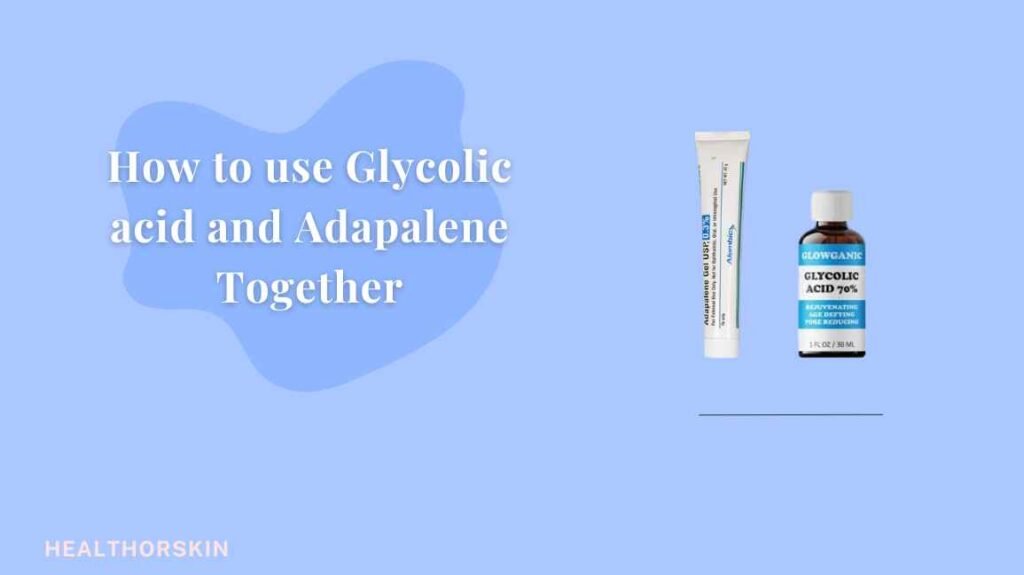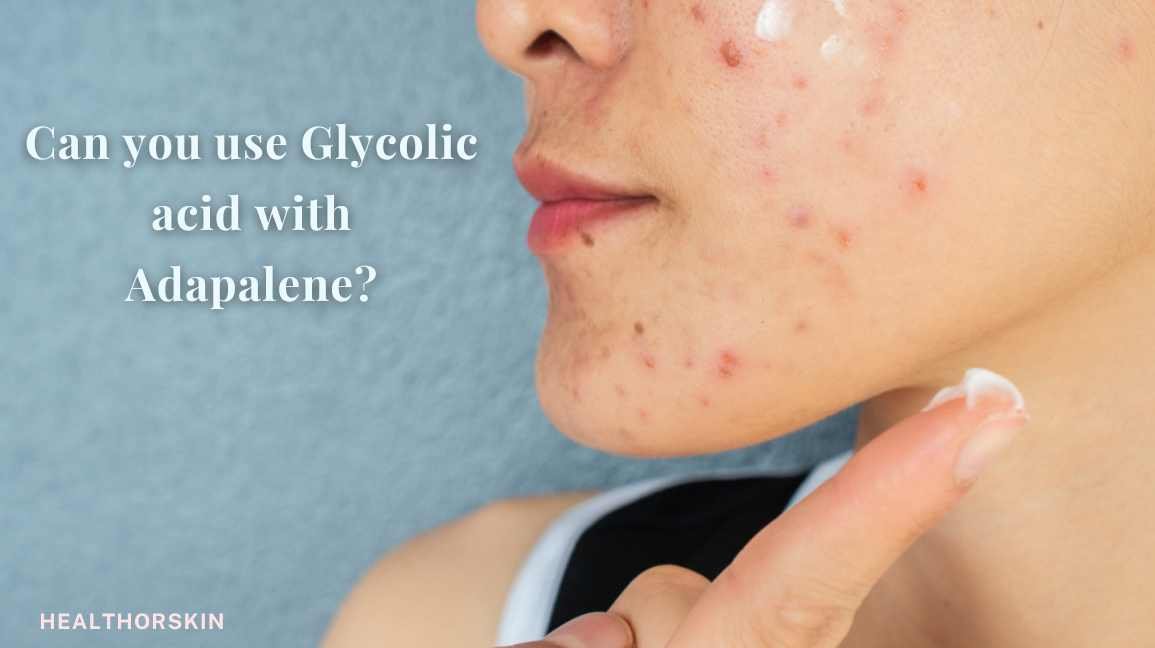When it comes to skincare, achieving a balanced and effective routine often means mixing different active ingredients to target specific issues.
Two such popular ingredients are glycolic acid and adapalene, which are frequently recommended by dermatologists for their impressive benefits. Glycolic acid, an alpha hydroxy acid (AHA), is renowned for its exfoliating properties, while adapalene is a retinoid that is celebrated for its acne-fighting capabilities.
However, the question arises: can these two powerful ingredients be used together safely and effectively? The short answer is yes, you can use both of them together, but it is important to understand how each ingredient works, and there are some key points to keep in mind before using them.
This article aims to provide a complete guide on using glycolic acid and adapalene together, including the benefits, potential risks, and best practices for incorporating them into your skincare routine.
What is Glycolic acid?
Glycolic acid is a type of alpha hydroxy acid (AHA) derived from sugarcane and is known for its exfoliating properties. It helps get rid of dead skin cells, unclog pores, smooth out skin texture, and boost cell turnover.
Glycolic acid is often used to treat acne, fine lines, wrinkles, hyperpigmentation, and dull skin.
What Does Glycolic acid do for skin?
Here’s a breakdown of why glycolic acid is such a superstar ingredient in the skincare world, dropping the technical terms for a more natural flow:
- Turning Back Time: Glycolic acid combats fine lines and wrinkles, smoothing creases and uneven texture, giving your skin a firmer, more youthful appearance.
- Hydration Hero: Dry, flaky skin? No more! Glycolic acid attracts moisture, plumping up your skin and keeping it hydrated for a healthy, dewy glow.
- Sun Damage Savior: Sun exposure can cause dark spots. Glycolic acid fades blemishes and protects your skin’s collagen from further sun damage.
- Brighter, Bolder You: Regular use of glycolic acid brightens your complexion, giving you a radiant, even-toned look. It’s like hitting the refresh button for your skin!
- Exfoliation Magic: Say goodbye to ingrown hairs and clogged pores! Glycolic acid gently exfoliates dead skin cells, preventing ingrown hairs and making pores appear smaller.
- Acne Annihilator: Breakouts got you down? Glycolic acid helps keep pores clear by preventing comedones, blackheads, and inflamed breakouts.
- Fading Those Dark Spots: Glycolic acid not only addresses sun damage but also helps fade hyperpigmentation, leaving you with a more even skin tone.
Read also: Can you switch from Adapalene to Tretinoin?
What is Adapalene and its benefits?
Adapalene is a type of retinoid that is often used to treat acne. It works by preventing the formation of new acne lesions and promoting skin cell turnover.
Adapalene is known for its ability to unclog pores, reduce inflammation, and prevent breakouts. It is commonly used in the treatment of mild to moderate acne.
Benefits of Adapalene:
- Acne Reduction: Adapalene works by unclogging pores, reducing inflammation, and preventing the formation of new blemishes.
- Scarring Prevention: By minimizing inflammation, Adapalene can help prevent the development of acne scars.
- Scar Improvement: In some cases, Adapalene may even improve the appearance of existing acne scars.
Can you use them together?
Yes, glycolic acid and adapalene can be used together effectively, but it is important to understand a few things before adding them into your routine.
While both glycolic acid and Adapalene offer significant benefits for the skin, using them together can be tricky. Both ingredients can be irritating, so it’s important to be gentle with your skin. Here are some key points to keep in mind before using them:
- Steady Taster: Apply one product at a time and wait at least a week before adding another. This allows your skin to adjust to each ingredient individually and minimizes the risk of irritation.
- Nighttime Application: Both glycolic acid and Adapalene can make your skin more sensitive to sunlight. It’s best to apply them at night to minimize sun exposure.
- Moisturize: Regularly applying a fragrance-free moisturizer helps replenish hydration lost due to the exfoliating effects of glycolic acid and the potential drying effect of Adapalene.
- Patch Testing: Before applying any new product to your entire face, do a patch test on a small, inconspicuous area like your jawline. Apply a small amount and wait 24 hours to check for any reaction.
It is generally not recommended to use Glycolic acid and Adapalene at the same time, as they can be too harsh for the skin and cause irritation.
However, some dermatologists may recommend alternating the use of Glycolic acid and Adapalene on different days to prevent sensitivity and achieve the desired results.
Related: Does Winlevi Cause Skin Purging?
How to use Glycolic acid and Adapalene Together?

Here is some tips on how to safely use glycolic acid and Adapalene (retinol) together.
Starting Slow is Key:
- Retinol First: Start gently with retinol, applying it once a week at night. This lets your skin adjust to its powerful effects. Gradually increase usage to a few nights a week, eventually working your way up to every other night if your skin tolerates it well. Remember, this process can take a few months, so be patient.
- Glycolic Acid Next: Once your skin feels comfortable with retinol, start using a glycolic acid product. Apply it on nights when you skip retinol to avoid overwhelming your skin. Similar to retinol, gradually increase usage to every other night if your skin allows.
Daylight Defense is Essential:
- Morning and Night: If your skin feels happy, try using a glycolic acid product in the morning and a retinol cream or serum at night. This maximizes the benefits of each ingredient.
- Shield and Hydrate: Never skip moisturizer and sunscreen. Retinol increases sun sensitivity and can be drying. Layer a gentle moisturizer after each application and apply sunscreen every single day, even on cloudy days. Look for a broad-spectrum SPF 30 or higher.
Listen to Your Skin:
- Less is more: Don’t rush with high concentrations. Start with low percentages and gradually increase as tolerated. Remember, even with slow integration, some dryness, redness, or flaking might occur initially. If this persists or worsens, take a break and consult a dermatologist.
- Expert Advice: Don’t hesitate to chat with your dermatologist. They can assess your skin, recommend the best product strengths for your unique needs, and address any concerns you might have.
Possible Side Effects and Management Tips
Using glycolic acid and Adapalene together can cause side effects because they are strong exfoliants and retinoids. Here are some side effects you might experience if you use both together:
- Initial Irritation: It’s normal to have some irritation at first, like redness, dryness, or peeling. This happens as your skin gets used to the active ingredients.
- Increased Sensitivity: Both glycolic acid and Adapalene can make your skin more sensitive to environmental factors, especially UV radiation. Always use a broad-spectrum sunscreen with at least SPF 30 to keep your skin safe from sun damage.
- Dryness and Peeling: These side effects are common when starting Adapalene. Although glycolic acid helps with exfoliation, using both can make your skin drier and cause more peeling.
- Temporary Breakouts: Some users may experience a temporary increase in breakouts known as “purging” as their skin adjusts to retinoids like Adapalene. These breakouts usually clear up within a few weeks.
- Stinging and Burning Sensation: Using these products can make your skin feel a bit tingly or like it’s burning, especially if you have sensitive skin. This feeling usually gets better as your skin gets used to it.
- Hyperpigmentation: In some cases, improper use or overuse can cause post-inflammatory hyperpigmentation, especially in darker skin tones. Using both products together may increase the risk if not used cautiously.
How to manage these side effects:
To minimize these side effects:
- Introduce Gradually: Start with lower concentrations and slowly increase the frequency of application as your skin builds tolerance.
- Moisturize Frequently: Combat dryness and peeling by using a high-quality, fragrance-free moisturizer regularly.
- Sun Protection: Never skip sunscreen in the morning, and try wearing a hat or seeking shade during peak sunlight hours like between 10 AM and 4 PM.
- Skip a Day: Give your skin a break by skipping a day or two between each application.
- Take it Slow: Don’t rush to use stronger products. Start with lower amounts and slowly use more if your skin handles it well. If you have bad or lasting side effects, talk to your skin doctor.
Taking these precautions can help you reap the benefits of glycolic acid and Adapalene while minimizing potential side effects.
Conclusion
In conclusion, glycolic acid and adapalene are potent ingredients that can help improve the overall health and appearance of the skin. While using them together may not be suitable for everyone, with proper guidance and caution, it is possible to incorporate both into your skincare routine effectively.
Consult with a dermatologist to determine the best approach for your skin concerns and achieve the desired results safely.
FAQ
Can I use Glycolic acid and Adapalene together every day?
It is generally not recommended to use glycolic acid and adapalene together daily, as it can lead to skin irritation. Consult with a dermatologist for a personalized skincare routine.
How long does it take to see results from using Glycolic acid and Adapalene?
Depending on the specific skin issues, different results may be obtained by applying Adapalene and Glycolic acid. It may take a few weeks to see visible improvements in skin tone, texture, and acne.
Can I use Glycolic acid and Adapalene if I have sensitive skin?
People with sensitive skin should use glycolic acid and adapalene with caution, starting with low concentrations and gradually increasing frequency based on skin response.
“For radiant, healthy skin, understanding how to properly use glycolic acid and adapalene is essential. Consult with a skincare professional to create a tailored routine that suits your skin’s needs.”
Resources
- Very Well Health: https://www.verywellhealth.com/glycolic-acid-15774
- PubChem: https://pubchem.ncbi.nlm.nih.gov/compound/Glycolic-acid

Hello Friends!
My name is Ahmad, reading books and gaining knowledge about Health, skin and their conditions is my passion and I am here to share my knowledge and experience with you. I hope it’s very helpful for you.
Thank you very much.
